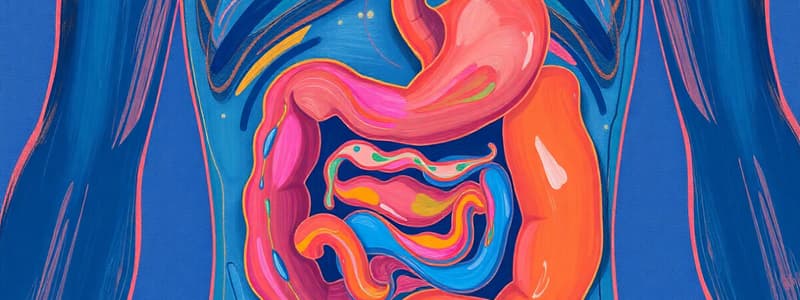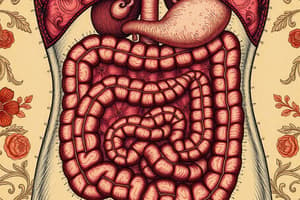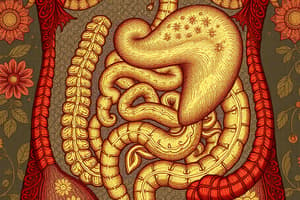Podcast
Questions and Answers
Which structure is responsible for producing bile that aids in digestion?
Which structure is responsible for producing bile that aids in digestion?
- Pancreas
- Gall bladder
- Liver (correct)
- Spleen
What is the primary function of the parotid salivary gland?
What is the primary function of the parotid salivary gland?
- Produce bile
- Secrete insulin
- Secrete salivary juice (correct)
- Regulate blood sugar
What is the role of mucus in saliva during digestion?
What is the role of mucus in saliva during digestion?
- To lubricate and bind food particles (correct)
- To neutralize stomach acid
- To provide taste to food
- To facilitate enzymatic reactions
Which structure guards the common hepato-pancreatic duct?
Which structure guards the common hepato-pancreatic duct?
What is the functional unit of the liver responsible for its metabolic activities?
What is the functional unit of the liver responsible for its metabolic activities?
What is the main function of the pancreas's exocrine portion?
What is the main function of the pancreas's exocrine portion?
Which process describes the muscular contractions that move the bolus down the esophagus?
Which process describes the muscular contractions that move the bolus down the esophagus?
Which of the following glands is located beneath the tongue?
Which of the following glands is located beneath the tongue?
What is the primary function of the epiglottis during swallowing?
What is the primary function of the epiglottis during swallowing?
Which part of the stomach is directly connected to the oesophagus?
Which part of the stomach is directly connected to the oesophagus?
What regulates the opening of the stomach into the duodenum?
What regulates the opening of the stomach into the duodenum?
Which segment of the small intestine is primarily responsible for digestion and absorption?
Which segment of the small intestine is primarily responsible for digestion and absorption?
Which layer is the outermost of the alimentary canal?
Which layer is the outermost of the alimentary canal?
What is the primary characteristic of the muscularis layer of the alimentary canal?
What is the primary characteristic of the muscularis layer of the alimentary canal?
Which of the following structures does the caecum connect to?
Which of the following structures does the caecum connect to?
Which is true about the vermiform appendix?
Which is true about the vermiform appendix?
What percentage of starch is hydrolysed by salivary amylase in the oral cavity?
What percentage of starch is hydrolysed by salivary amylase in the oral cavity?
Which type of cell in the gastric glands is responsible for secreting hydrochloric acid?
Which type of cell in the gastric glands is responsible for secreting hydrochloric acid?
What is the role of lysozyme in saliva?
What is the role of lysozyme in saliva?
What type of enzyme is pepsin and what does it act upon?
What type of enzyme is pepsin and what does it act upon?
What pH does hydrochloric acid create in the stomach, which is optimal for pepsin activity?
What pH does hydrochloric acid create in the stomach, which is optimal for pepsin activity?
What substance is required for the absorption of vitamin B12, secreted by gastric glands?
What substance is required for the absorption of vitamin B12, secreted by gastric glands?
Which enzyme found in the gastric juice of infants helps in the digestion of milk proteins?
Which enzyme found in the gastric juice of infants helps in the digestion of milk proteins?
Which digestive secretions are released into the small intestine through the hepato-pancreatic duct?
Which digestive secretions are released into the small intestine through the hepato-pancreatic duct?
What is the primary digestive function that takes place in the stomach?
What is the primary digestive function that takes place in the stomach?
Which enzyme is specifically responsible for breaking down starch into maltose?
Which enzyme is specifically responsible for breaking down starch into maltose?
What is the role of the ileo-caecal valve in the digestive system?
What is the role of the ileo-caecal valve in the digestive system?
What is the end product of carbohydrate digestion in the small intestine?
What is the end product of carbohydrate digestion in the small intestine?
Which substances are absorbed in the stomach?
Which substances are absorbed in the stomach?
What is the main purpose of bile in the digestive process?
What is the main purpose of bile in the digestive process?
Which digestive enzyme is responsible for the hydrolysis of starch?
Which digestive enzyme is responsible for the hydrolysis of starch?
In which part of the digestive system does the complete digestion of carbohydrates occur?
In which part of the digestive system does the complete digestion of carbohydrates occur?
What is the process by which absorbed substances reach the tissues for their activities?
What is the process by which absorbed substances reach the tissues for their activities?
Which of the following is a symptom that can signal the presence of jaundice?
Which of the following is a symptom that can signal the presence of jaundice?
Which digestive disorder is characterized by the irregular retention of faeces?
Which digestive disorder is characterized by the irregular retention of faeces?
Which of the following conditions involves the ejection of stomach contents through the mouth?
Which of the following conditions involves the ejection of stomach contents through the mouth?
What type of movement is primarily responsible for the voluntary process of defaecation?
What type of movement is primarily responsible for the voluntary process of defaecation?
Which accessory digestive gland is responsible for producing bile?
Which accessory digestive gland is responsible for producing bile?
Which factor is NOT a typical cause of indigestion?
Which factor is NOT a typical cause of indigestion?
What is the primary function of the tongue in the digestive process?
What is the primary function of the tongue in the digestive process?
Flashcards are hidden until you start studying
Study Notes
The Digestive System: A Journey Through the Alimentary Canal
- The alimentary canal is a long, continuous tube that begins at the mouth and ends at the anus.
- Its primary function is to digest and absorb nutrients from food.
- The mouth, which is the first part of the alimentary canal, contains teeth for chewing and a tongue for tasting and manipulating food.
- Saliva is secreted in the mouth by salivary glands, and contains the enzyme salivary amylase that begins the breakdown of starch into maltose.
- The pharynx is a common passageway for food and air, and the epiglottis prevents food from entering the trachea (windpipe) during swallowing.
- The oesophagus is a muscular tube that connects the pharynx to the stomach, propelling food through peristalsis, a series of rhythmic contractions.
- The stomach is a muscular, J-shaped organ located in the upper left abdomen, which mixes food with acidic gastric juice.
- Gastric juice contains pepsin which is a proteolytic enzyme that breaks down proteins.
- The small intestine, extending from the stomach to the large intestine, is where the majority of digestion and absorption occurs.
- The small intestine is subdivided into the duodenum, jejunum, and ileum.
- The pancreas secretes pancreatic juice containing enzymes that digest carbohydrates, proteins, and fats.
- The liver produces bile, which is stored in the gallbladder. Bile aids in fat digestion.
- The large intestine is responsible for water absorption and the formation of feces.
- Feces are expelled through the anus, the terminal opening of the digestive system.
Digestive System Structures: A Closer Look
- The serosa, the outermost layer of the digestive tract, is a protective membrane composed of connective tissue.
- The muscularis, located beneath the serosa, is responsible for the movement of food through the digestive tract.
- The submucosa is a layer of connective tissue that contains nerves, blood vessels, and lymph vessels.
- The mucosa, the innermost layer, contains glands that secrete digestive enzymes and mucus.
Accessory Digestive Glands: Supporting Players
- Salivary glands: Produce saliva, containing salivary amylase for starch digestion.
- Liver: Largest gland in the body, responsible for producing bile, detoxifying blood, and storing glucose.
- Gallbladder: Stores and concentrates bile.
- Pancreas: Both exocrine and endocrine gland, secreting digestive enzymes and hormones such as insulin and glucagon.
Digestive Processes: A Symphony of Breakdown
- Digestion encompasses both mechanical (chewing and churning) and chemical (enzyme action) processes.
- Absorption is the process of taking nutrients from the digestive tract into the bloodstream.
- Assimilation is the process of cells utilizing absorbed nutrients for growth and energy.
- Egestion is the elimination of undigested food as feces.
Disorders of the Digestive System: Common Ailments
- Inflammation: Bacterial or viral infections can result in inflammation of the intestinal tract.
- Jaundice: Yellowing of the skin and eyes caused by the buildup of bile pigments in the blood.
- Vomiting: Reflexive expulsion of stomach contents through the mouth.
- Diarrhea: Abnormal frequency and liquidity of bowel movements, leading to reduced nutrient absorption.
- Constipation: Irregular bowel movements with retention of feces in the rectum.
- Indigestion: Difficulty digesting food, often caused by inadequate enzyme secretion, anxiety, food poisoning, overeating, or spicy food.
Studying That Suits You
Use AI to generate personalized quizzes and flashcards to suit your learning preferences.




